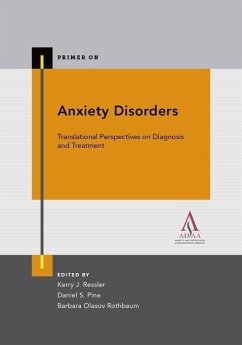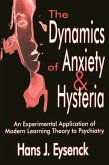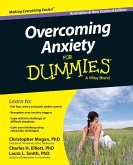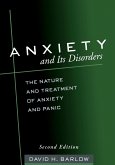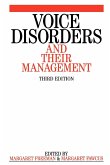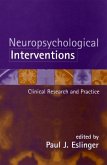Anxiety Disorders
Herausgeber: Ressler, Kerry; Rothbaum, Barbara; Pine, Daniel
Schade – dieser Artikel ist leider ausverkauft. Sobald wir wissen, ob und wann der Artikel wieder verfügbar ist, informieren wir Sie an dieser Stelle.
Anxiety Disorders
Herausgeber: Ressler, Kerry; Rothbaum, Barbara; Pine, Daniel
- Broschiertes Buch
- Merkliste
- Auf die Merkliste
- Bewerten Bewerten
- Teilen
- Produkt teilen
- Produkterinnerung
- Produkterinnerung
The Primer on Anxiety Disorders provides early-stage practitioners and trainees - as well as seasoned clinicians and researchers - with need-to-know information designed to assist in the diagnosis and treatment of anxiety disorders.
Andere Kunden interessierten sich auch für
![The Dynamics of Anxiety and Hysteria The Dynamics of Anxiety and Hysteria]() Hans EysenckThe Dynamics of Anxiety and Hysteria64,99 €
Hans EysenckThe Dynamics of Anxiety and Hysteria64,99 €![Overcoming Anxiety for Dummies - Australia / Nz Overcoming Anxiety for Dummies - Australia / Nz]() Christopher MoganOvercoming Anxiety for Dummies - Australia / Nz22,99 €
Christopher MoganOvercoming Anxiety for Dummies - Australia / Nz22,99 €![Anxiety and Its Disorders Anxiety and Its Disorders]() David H BarlowAnxiety and Its Disorders97,99 €
David H BarlowAnxiety and Its Disorders97,99 €![Generalized Anxiety Disorders Generalized Anxiety Disorders]() Generalized Anxiety Disorders46,99 €
Generalized Anxiety Disorders46,99 €![Voice Disorders and their Management 3e Voice Disorders and their Management 3e]() Margaret FreemanVoice Disorders and their Management 3e90,99 €
Margaret FreemanVoice Disorders and their Management 3e90,99 €![Neuropsychological Interventions Neuropsychological Interventions]() Paul J. Eslinger (ed.)Neuropsychological Interventions49,99 €
Paul J. Eslinger (ed.)Neuropsychological Interventions49,99 €
The Primer on Anxiety Disorders provides early-stage practitioners and trainees - as well as seasoned clinicians and researchers - with need-to-know information designed to assist in the diagnosis and treatment of anxiety disorders.
Produktdetails
- Produktdetails
- Verlag: Oxford University Press
- Seitenzahl: 528
- Erscheinungstermin: 13. Mai 2015
- Englisch
- Abmessung: 249mm x 175mm x 28mm
- Gewicht: 930g
- ISBN-13: 9780199395125
- ISBN-10: 0199395128
- Artikelnr.: 47868951
- Herstellerkennzeichnung
- Libri GmbH
- Europaallee 1
- 36244 Bad Hersfeld
- gpsr@libri.de
- Verlag: Oxford University Press
- Seitenzahl: 528
- Erscheinungstermin: 13. Mai 2015
- Englisch
- Abmessung: 249mm x 175mm x 28mm
- Gewicht: 930g
- ISBN-13: 9780199395125
- ISBN-10: 0199395128
- Artikelnr.: 47868951
- Herstellerkennzeichnung
- Libri GmbH
- Europaallee 1
- 36244 Bad Hersfeld
- gpsr@libri.de
Kerry J. Ressler, Professor of Psychiatry and Behavioral Sciences at Emory University, received his B.S. degree in molecular biology from M.I.T., and his M.D./Ph.D. from Harvard Medical School. His work focuses on translational research bridging molecular neurobiology in animal models with human genetic research. His basic and clinical research examines neurobiological, molecular, genetic and behavioral processes that underlie fear related processing and Posttraumatic Stress Disorder. Dr. Daniel S. Pine is Chief, Section on Development and Affective Neuroscience, in the National Institute of Mental Health Intramural Research Program. Since graduating from medical school at the University of Chicago, Dr. Pine has been engaged continuously in research on pediatric mental disorders. Currently, his group examines the degree to which mood and anxiety disorders in children and adolescents are associated with abnormalities in the amygdala, prefrontal cortex, and brain regions that modulate these structures. Barbara Olasov Rothbaum, Ph.D. is a professor in psychiatry and Associate Vice Chair of Clinical Research at the Emory School of Medicine in the Department of Psychiatry and Behavioral Sciences and director of the Trauma and Anxiety Recovery Program at Emory. Dr. Rothbaum specializes in research on the treatment of individuals with anxiety disorders, particularly focusing on Posttraumatic Stress Disorder (PTSD).
* Foreword: Anxiety Disorders, Big Science, and Big Data: The Next
Generation of Science and Practice
* Section 1: Overview of Anxiety and Related Illnesses
* 1. Anxiety and Related Disorders in DSM5.
* 2. Translational Perspectives, RDoC and Anxiety.
* Section 2: Neurobiology and Neural Circuitry of Anxiety Disorders
* 3. Neurobiology and Neuroimaging of Fear and Anxiety Circuitry.
* 4. The Genetics of Anxiety Disorders.
* Section 3: Development of Fear, Fear Pathways, and Anxiety Disorders
in Children and Adolescents
* 5. Developmental Biology related to Emotion and Anxiety.
* 6. Development of Fear and its Inhibition
* 7. Involving the Family in Treatment.
* 8. Treating the College-age Patient.
* Section 4: Posttraumatic Stress and the Neurobiology of Trauma
* 9. PTSD and the Biology of the Stress Response.
* 10. Clinical Aspects of Trauma-related Anxiety and PTSD.
* Section 6: Obsessive Compulsive and Disorders of Cortical-Striatal
Processing
* 11. Dissecting OCD Circuits: From Animal Models to Targeted
Treatments.
* 12. Clinical aspects of Obsessive Compulsive Disorder.
* Section 7: Phobias, Fears, and Panic
* 13. The Etiology of Fear and Anxiety: The Role of Environmental
Exposures.
* 14. Clinical Aspects of Social Anxiety Disorder and Specific Phobias.
* 15. Clinical aspects of Panic disorder.
* Section 8: Intersection of Medical and Anxiety Disorders
* 16. Fear, Anxiety, Avoidance, and Chronic Pain.
* 17. Detection and Treatment of Anxiety Disorders in Primary Care
Settings.
* 18. Gastrointestinal Disorders, Irritable Bowel Syndrome, and
Anxiety.
* 19. Anxiety Disorders and Cardiovascular Illness.
* Section 9: Intersection of Anxiety with Mood and Substance Disorders
* 20. Substance abuse and Comorbidity with Anxiety.
* 21. Comorbidity of Anxiety and Depression.
* 22. Generalized Anxiety Disorder.
* 23. Anxiety and Suicide.
* Section 10: Cognitive and Exposure Based Treatments of Anxiety
Disorders
* 24. Neural Circuitry Mechanisms of Fear Extinction.
* 25. Learning Theory and Cognitive Behavioral Therapy.
* 26. Pharmacological Mechanisms of Modulating Fear and Extinction.
* Section 11: Neurotransmitter Pathways and Pharmacological Treatments
of Anxiety Disorders
* 27. Stress, Anxiety, Depression and the Role of Glutamate
Neurotransmission.
* 28. The Role of the Hypothalamic-Pituitary-Adrenal Axis in Anxiety
Disorders.
* 29. Pharmacological Interventions for Adult Anxiety Disorders.
* Section 12: New Technologies and Approaches to Treatment
* 30. Adherence to Psychotherapy and Pharmacotherapy for Anxiety
Disorders.
* 31. Computer Tools as Novel Treatment for Depression and Anxiety.
* 32. Internet-Based Treatment for Anxiety, OCD, and Related Disorders.
Generation of Science and Practice
* Section 1: Overview of Anxiety and Related Illnesses
* 1. Anxiety and Related Disorders in DSM5.
* 2. Translational Perspectives, RDoC and Anxiety.
* Section 2: Neurobiology and Neural Circuitry of Anxiety Disorders
* 3. Neurobiology and Neuroimaging of Fear and Anxiety Circuitry.
* 4. The Genetics of Anxiety Disorders.
* Section 3: Development of Fear, Fear Pathways, and Anxiety Disorders
in Children and Adolescents
* 5. Developmental Biology related to Emotion and Anxiety.
* 6. Development of Fear and its Inhibition
* 7. Involving the Family in Treatment.
* 8. Treating the College-age Patient.
* Section 4: Posttraumatic Stress and the Neurobiology of Trauma
* 9. PTSD and the Biology of the Stress Response.
* 10. Clinical Aspects of Trauma-related Anxiety and PTSD.
* Section 6: Obsessive Compulsive and Disorders of Cortical-Striatal
Processing
* 11. Dissecting OCD Circuits: From Animal Models to Targeted
Treatments.
* 12. Clinical aspects of Obsessive Compulsive Disorder.
* Section 7: Phobias, Fears, and Panic
* 13. The Etiology of Fear and Anxiety: The Role of Environmental
Exposures.
* 14. Clinical Aspects of Social Anxiety Disorder and Specific Phobias.
* 15. Clinical aspects of Panic disorder.
* Section 8: Intersection of Medical and Anxiety Disorders
* 16. Fear, Anxiety, Avoidance, and Chronic Pain.
* 17. Detection and Treatment of Anxiety Disorders in Primary Care
Settings.
* 18. Gastrointestinal Disorders, Irritable Bowel Syndrome, and
Anxiety.
* 19. Anxiety Disorders and Cardiovascular Illness.
* Section 9: Intersection of Anxiety with Mood and Substance Disorders
* 20. Substance abuse and Comorbidity with Anxiety.
* 21. Comorbidity of Anxiety and Depression.
* 22. Generalized Anxiety Disorder.
* 23. Anxiety and Suicide.
* Section 10: Cognitive and Exposure Based Treatments of Anxiety
Disorders
* 24. Neural Circuitry Mechanisms of Fear Extinction.
* 25. Learning Theory and Cognitive Behavioral Therapy.
* 26. Pharmacological Mechanisms of Modulating Fear and Extinction.
* Section 11: Neurotransmitter Pathways and Pharmacological Treatments
of Anxiety Disorders
* 27. Stress, Anxiety, Depression and the Role of Glutamate
Neurotransmission.
* 28. The Role of the Hypothalamic-Pituitary-Adrenal Axis in Anxiety
Disorders.
* 29. Pharmacological Interventions for Adult Anxiety Disorders.
* Section 12: New Technologies and Approaches to Treatment
* 30. Adherence to Psychotherapy and Pharmacotherapy for Anxiety
Disorders.
* 31. Computer Tools as Novel Treatment for Depression and Anxiety.
* 32. Internet-Based Treatment for Anxiety, OCD, and Related Disorders.
* Foreword: Anxiety Disorders, Big Science, and Big Data: The Next
Generation of Science and Practice
* Section 1: Overview of Anxiety and Related Illnesses
* 1. Anxiety and Related Disorders in DSM5.
* 2. Translational Perspectives, RDoC and Anxiety.
* Section 2: Neurobiology and Neural Circuitry of Anxiety Disorders
* 3. Neurobiology and Neuroimaging of Fear and Anxiety Circuitry.
* 4. The Genetics of Anxiety Disorders.
* Section 3: Development of Fear, Fear Pathways, and Anxiety Disorders
in Children and Adolescents
* 5. Developmental Biology related to Emotion and Anxiety.
* 6. Development of Fear and its Inhibition
* 7. Involving the Family in Treatment.
* 8. Treating the College-age Patient.
* Section 4: Posttraumatic Stress and the Neurobiology of Trauma
* 9. PTSD and the Biology of the Stress Response.
* 10. Clinical Aspects of Trauma-related Anxiety and PTSD.
* Section 6: Obsessive Compulsive and Disorders of Cortical-Striatal
Processing
* 11. Dissecting OCD Circuits: From Animal Models to Targeted
Treatments.
* 12. Clinical aspects of Obsessive Compulsive Disorder.
* Section 7: Phobias, Fears, and Panic
* 13. The Etiology of Fear and Anxiety: The Role of Environmental
Exposures.
* 14. Clinical Aspects of Social Anxiety Disorder and Specific Phobias.
* 15. Clinical aspects of Panic disorder.
* Section 8: Intersection of Medical and Anxiety Disorders
* 16. Fear, Anxiety, Avoidance, and Chronic Pain.
* 17. Detection and Treatment of Anxiety Disorders in Primary Care
Settings.
* 18. Gastrointestinal Disorders, Irritable Bowel Syndrome, and
Anxiety.
* 19. Anxiety Disorders and Cardiovascular Illness.
* Section 9: Intersection of Anxiety with Mood and Substance Disorders
* 20. Substance abuse and Comorbidity with Anxiety.
* 21. Comorbidity of Anxiety and Depression.
* 22. Generalized Anxiety Disorder.
* 23. Anxiety and Suicide.
* Section 10: Cognitive and Exposure Based Treatments of Anxiety
Disorders
* 24. Neural Circuitry Mechanisms of Fear Extinction.
* 25. Learning Theory and Cognitive Behavioral Therapy.
* 26. Pharmacological Mechanisms of Modulating Fear and Extinction.
* Section 11: Neurotransmitter Pathways and Pharmacological Treatments
of Anxiety Disorders
* 27. Stress, Anxiety, Depression and the Role of Glutamate
Neurotransmission.
* 28. The Role of the Hypothalamic-Pituitary-Adrenal Axis in Anxiety
Disorders.
* 29. Pharmacological Interventions for Adult Anxiety Disorders.
* Section 12: New Technologies and Approaches to Treatment
* 30. Adherence to Psychotherapy and Pharmacotherapy for Anxiety
Disorders.
* 31. Computer Tools as Novel Treatment for Depression and Anxiety.
* 32. Internet-Based Treatment for Anxiety, OCD, and Related Disorders.
Generation of Science and Practice
* Section 1: Overview of Anxiety and Related Illnesses
* 1. Anxiety and Related Disorders in DSM5.
* 2. Translational Perspectives, RDoC and Anxiety.
* Section 2: Neurobiology and Neural Circuitry of Anxiety Disorders
* 3. Neurobiology and Neuroimaging of Fear and Anxiety Circuitry.
* 4. The Genetics of Anxiety Disorders.
* Section 3: Development of Fear, Fear Pathways, and Anxiety Disorders
in Children and Adolescents
* 5. Developmental Biology related to Emotion and Anxiety.
* 6. Development of Fear and its Inhibition
* 7. Involving the Family in Treatment.
* 8. Treating the College-age Patient.
* Section 4: Posttraumatic Stress and the Neurobiology of Trauma
* 9. PTSD and the Biology of the Stress Response.
* 10. Clinical Aspects of Trauma-related Anxiety and PTSD.
* Section 6: Obsessive Compulsive and Disorders of Cortical-Striatal
Processing
* 11. Dissecting OCD Circuits: From Animal Models to Targeted
Treatments.
* 12. Clinical aspects of Obsessive Compulsive Disorder.
* Section 7: Phobias, Fears, and Panic
* 13. The Etiology of Fear and Anxiety: The Role of Environmental
Exposures.
* 14. Clinical Aspects of Social Anxiety Disorder and Specific Phobias.
* 15. Clinical aspects of Panic disorder.
* Section 8: Intersection of Medical and Anxiety Disorders
* 16. Fear, Anxiety, Avoidance, and Chronic Pain.
* 17. Detection and Treatment of Anxiety Disorders in Primary Care
Settings.
* 18. Gastrointestinal Disorders, Irritable Bowel Syndrome, and
Anxiety.
* 19. Anxiety Disorders and Cardiovascular Illness.
* Section 9: Intersection of Anxiety with Mood and Substance Disorders
* 20. Substance abuse and Comorbidity with Anxiety.
* 21. Comorbidity of Anxiety and Depression.
* 22. Generalized Anxiety Disorder.
* 23. Anxiety and Suicide.
* Section 10: Cognitive and Exposure Based Treatments of Anxiety
Disorders
* 24. Neural Circuitry Mechanisms of Fear Extinction.
* 25. Learning Theory and Cognitive Behavioral Therapy.
* 26. Pharmacological Mechanisms of Modulating Fear and Extinction.
* Section 11: Neurotransmitter Pathways and Pharmacological Treatments
of Anxiety Disorders
* 27. Stress, Anxiety, Depression and the Role of Glutamate
Neurotransmission.
* 28. The Role of the Hypothalamic-Pituitary-Adrenal Axis in Anxiety
Disorders.
* 29. Pharmacological Interventions for Adult Anxiety Disorders.
* Section 12: New Technologies and Approaches to Treatment
* 30. Adherence to Psychotherapy and Pharmacotherapy for Anxiety
Disorders.
* 31. Computer Tools as Novel Treatment for Depression and Anxiety.
* 32. Internet-Based Treatment for Anxiety, OCD, and Related Disorders.

